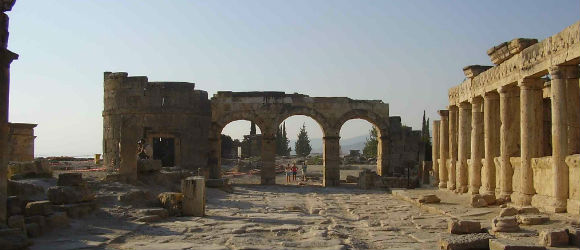The presence of a hot spring at Hierapolis and the spectacular calcium deposits from its water spilling over the nearby hillside suggest that there should be evidence of an early settlement there. The oldest Inscription found so far, however, indicates it was founded by Eumenes II, king of Pergamon, in the latter part of the second century B.C.; it soon became a busy industrial center.
Pagan worship in the city centered around Cybele, Apollo, Artemis, Men, Poseidon, and Pluto. Underneath the Temple of Apollo has been found the Plutonium, an opening in the earth from which a noxious gas still comes. The temple is between the pool where the hot spring rises and the large theater on the side of the hill. To the north along the rim of the plateau is a long avenue of tombs.
Traditionally St. Philip is connected with the early church in Hierapolis. Fairly recently Italian archeologlsts have discovered his Martyrium, an octagonal chamber forming a double cross surrounded by a square. This is almost due north of the theater, also on the side of the hill. It was a fifth century A.D. building and did not last much more than 100 years. No tomb was found with it although that was expected. There are several ruins of churches, one not far from the baths, one on the main road leading to the necropolis.
Hierapolis is listed in the New Testament along with Laodicea as the center of Epaphras’s work (Colos-sians 4:13). This was at the time Paul was writing to strengthen the message Epaphras was preaching and to condemn the “people who go in for self-mortification and angel-worship” (Colossians 2:18). Another less well-known resident of Hierapolis was Papias, a disciple of St. John and the author of the lost book called the Sayings of Jesus.
While Epaphras was is that area, a young slave was growing up in Hierapolis, a boy whose original name is unknown but whom we call by the Greek for “Acquired”, Epictetus. In his Discourses Epictetus often talks about the perfect missionary whose bed was the ground, whose only house the earth and sky and a shabby cloak, and who must love those who misuse him in the service of God. One wonders what the influence of those early Christians, many of whom were slaves themselves, was on this Stoic philosopher.
Hierapolis,


This sight is absolutely breathtaking and not to be missed if you are in Turkey. The calcium waters have etched out sparkling pools of blue waters against a background of pure white cliffs. If you wish to walk in the pools it's mandatory to remove your shoes. As the weather was quite cool we thought it would be difficult to…
Very interesting area, enjoyed it a lot ! A little tricky to get into the water as there were loads of visitors but nevertheless all good!
If you walk to Hierapolis (not far from most Pamukkale hotels) you enter a gate where the only way in is to take off your shoes and walk up the travertines. It is not slippery, but a little rough on the feet. We met an elderly woman trying to make her way up. She was really worried about slipping and…
This place govern by unesco…thank godness, very interenting place for ancient culture in romawi century
This place is magic with thermal pools just from two minutes walking. I recomend this place for his history and for the landscape.
Have always wanted to visit this splendid site and were not disappointed. As our tour arrived here early in the morning, we did not have to put up with too much of a crowd. Can highly recommend this place as the scenery is most unusual.
Both fascinating in different ways but not to be missed.
Such a wonder of the world. World heritage by unesco..İn Turkey.Calcium pools are looks like frozen water fall ..
We loved the friendly staff of the site, nice warm water in the Antique Pool and of course the travertines!
Not just beautiful ruins, but they are just on top of special nature site – Cotton castle, I cant choose which of them is more important to see, but everybody is just lucky to be there and feel special aura of the place. Same feelings I have at only one place before – Delfi, Greece.